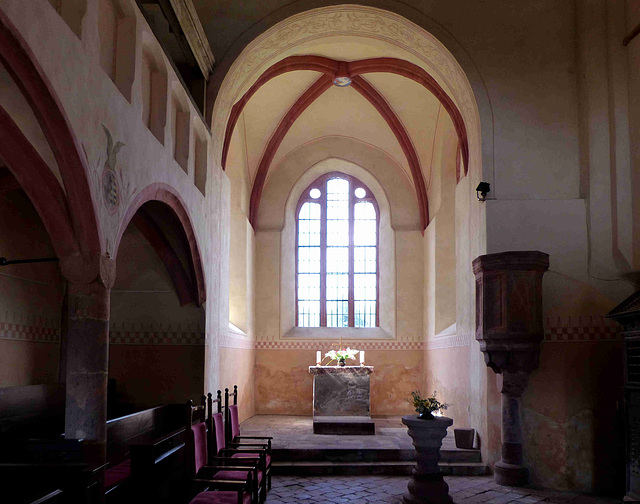Kloster Buch
Kloster Buch
Kloster Buch
Koprzywnica - Opactwo Cystersów
Koprzywnica - Opactwo Cystersów
Koprzywnica - Opactwo Cystersów
Koprzywnica - Opactwo Cystersów
Koprzywnica - Opactwo Cystersów
Koprzywnica - Kościół Matki Bożej Różańcowej
Wąchock - Klasztorny Cystersów
Wąchock - Klasztorny Cystersów
Wąchock - Klasztorny Cystersów
Wąchock - Klasztorny Cystersów
Wąchock - Klasztorny Cystersów
Wąchock - Klasztorny Cystersów
Wąchock - Klasztorny Cystersów
Wąchock - Klasztorny Cystersów
Parnoy-en-Bassigny - Abbaye de Morimond
Parnoy-en-Bassigny - Abbaye de Morimond
Parnoy-en-Bassigny - Abbaye de Morimond
Parnoy-en-Bassigny - Abbaye de Morimond
Location
See also...
Keywords
Authorizations, license
-
Visible by: Everyone -
All rights reserved
-
23 visits
Kloster Buch


Kloster Buch is located about 4 km east of the town of Leisnig in a bend of the river Freiberger Mulde.
Kloster Buch was first mentioned in a document of Emperor Heinrich IV who bestowed to it the parish of Leisnig. According to Cistercian tradition abbot Hildebert, twelve monks and twelve lay brothers left Sittichenbach Abbey in 1192 and reached Buch in 1192. Kloster Buch is therefore a filial abbey of Sittichenbach, their primary abbey is Morimond.
The Burgraves of Leisnig gifted the monastery with many villages. It also possessed several granges in the surrounding regions. In 1309 the monastery acquired the town of Belgern, where it established a ferry across the river Elbe. In 1486 a Cistercian school was founded in Belgern which prepared young monks for their studies, in particular at the Cistercian college of Leipzig University.
After the abbot died in 1525, the monastery was dissolved in the course of the Protestant Reformation which had already prevailed in nearby Leisnig. Prince-elector Johann der Beständige (John the Steadfast) had the election of a new abbot suppressed and ordered the properties of the abbey to be administrated by his representative. The monks were offered – according to their rank – parts of the property of the monastery as means of subsistence, or money to take up a civil trade.
It was so damaged during the Thirty Years' War that it had to be auctioned off. It was purchased at auction by the Fürstenschule Grimma (Grimma School of Princes). In 1678 the chapel was consecrated again after appropriate renovations. The school administered the remaining monastery property until 1836, after which it became a Saxon state domain. Leaseholders maintained operations in Buch.
After 1945, the estate was converted into a state-owned estate as part of the land reform. After 1990, the successor company gave up the agricultural use of the monastery complex in 1994.
The chapel was built around 1600 by the then owner. In the days of the GDR it served as a storage room.
Kloster Buch was first mentioned in a document of Emperor Heinrich IV who bestowed to it the parish of Leisnig. According to Cistercian tradition abbot Hildebert, twelve monks and twelve lay brothers left Sittichenbach Abbey in 1192 and reached Buch in 1192. Kloster Buch is therefore a filial abbey of Sittichenbach, their primary abbey is Morimond.
The Burgraves of Leisnig gifted the monastery with many villages. It also possessed several granges in the surrounding regions. In 1309 the monastery acquired the town of Belgern, where it established a ferry across the river Elbe. In 1486 a Cistercian school was founded in Belgern which prepared young monks for their studies, in particular at the Cistercian college of Leipzig University.
After the abbot died in 1525, the monastery was dissolved in the course of the Protestant Reformation which had already prevailed in nearby Leisnig. Prince-elector Johann der Beständige (John the Steadfast) had the election of a new abbot suppressed and ordered the properties of the abbey to be administrated by his representative. The monks were offered – according to their rank – parts of the property of the monastery as means of subsistence, or money to take up a civil trade.
It was so damaged during the Thirty Years' War that it had to be auctioned off. It was purchased at auction by the Fürstenschule Grimma (Grimma School of Princes). In 1678 the chapel was consecrated again after appropriate renovations. The school administered the remaining monastery property until 1836, after which it became a Saxon state domain. Leaseholders maintained operations in Buch.
After 1945, the estate was converted into a state-owned estate as part of the land reform. After 1990, the successor company gave up the agricultural use of the monastery complex in 1994.
The chapel was built around 1600 by the then owner. In the days of the GDR it served as a storage room.
Alexander Prolygin, Marco F. Delminho have particularly liked this photo
- Keyboard shortcuts:
Jump to top
RSS feed- Latest comments - Subscribe to the comment feeds of this photo
- ipernity © 2007-2024
- Help & Contact
|
Club news
|
About ipernity
|
History |
ipernity Club & Prices |
Guide of good conduct
Donate | Group guidelines | Privacy policy | Terms of use | Statutes | In memoria -
Facebook
Twitter

Sign-in to write a comment.